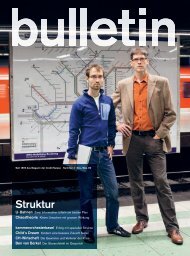Innovation
Global Investor Focus, 02/2007 Credit Suisse
Global Investor Focus, 02/2007
Credit Suisse
You also want an ePaper? Increase the reach of your titles
YUMPU automatically turns print PDFs into web optimized ePapers that Google loves.
GLOBAL INVESTOR FOCUS <strong>Innovation</strong> — 37<br />
Robotics<br />
The robot market will grow<br />
bn JPY<br />
7000<br />
6000<br />
5000<br />
4000<br />
3000<br />
2000<br />
100<br />
0<br />
2004 2010E 2025E<br />
Larger peer, iRobot, has sold<br />
over two million units that help<br />
people keep clean.<br />
2,000,000 units<br />
Source: JETRO, METI<br />
Robotics “is developing in much the same way as the computer<br />
business did 30 years ago,” according to someone who should<br />
know – Bill Gates. The South Korean Ministry of Information and<br />
Communication plans to have a robot in every home there by 2013.<br />
In Japan, where the robot industry began in the late 1960s, development<br />
has moved well beyond factory automation, to becoming<br />
an integrated aide to daily life.<br />
Japan’s Ministry of Economy, Trade and Industry’s Next-<br />
Generation Robot Vision Panel estimates the robot market will<br />
grow to JPY 1.8 trillion in 2010 and JPY 6.2 trillion in 2025. Honda<br />
Motors’ charismatic humanoid robot, Asimo, is widely known, but<br />
the Honda Research Institute is going much further, conducting<br />
in-depth research to build a “brain computer,” a manufactured<br />
device that would work exactly like a human brain.<br />
Such levels of artificial intelligence would allow robots to adaptively<br />
interact with humans in the real world and learn from the<br />
situations they encounter. NEC’s PaPeRo can not only entertain<br />
children with conversations and quizzes, but also perform voice<br />
and face identification to distinguish which child is which. It can<br />
recognize who gave the right answer in a quiz, for example. More<br />
importantly it can take attendance numbers, so if somebody is<br />
not there, PaPeRo will know. If a parent contacts PaPeRo from a<br />
mobile phone, the robot can locate the relevant child and transmit<br />
the scene by video, while the parent and child communicate by<br />
videophone.<br />
Toyota recently introduced several eye-opening examples of<br />
mass-produced artificial intelligence. Its flagship Lexus cars can<br />
be equipped with an intelligent parking system that allows a driver<br />
to park the car backwards or sideways into a parking lot by indicating<br />
the desired space on a touch-sensitive video screen on the<br />
dashboard. Sensors evaluate distances and help precisely maneuver<br />
into the lot with little ado from the driver. The company is also<br />
developing systems that it calls judgment-assist functions, which<br />
help the driver to avoid danger and make appropriate maneuvers.<br />
Robotics is unique in being one of the focal points of the global<br />
arms race, while also being one of the key beneficiaries of the<br />
socioeconomic creative forces unleashed by global connectivity<br />
technologies such as the Internet. During this year’s FIRST Robotics<br />
Competition, 32,500 students on 1,303 school teams from 23<br />
countries competed to build the best robot.<br />
At this early stage of the industry’s development, most pure<br />
plays with financials stable enough to trade publicly have large<br />
government contracts, but remain in the small-cap category. Aero-<br />
Vironment conducted a public equity offering in January. It supplies<br />
parts and systems to the unmanned aircraft industry (80% of<br />
sales). At present, most of these vehicles are capable of being<br />
carried by one man (man-portable) and designed for reconnaissance.<br />
The company is also developing a solar-powered unmanned<br />
vehicle on which it hopes to house 3G cellular communications<br />
transmitters. This initiative includes the US and Japanese governments<br />
and NEC/Toshiba. The other 20% of AeroVironment’s sales<br />
comes from innovative energizer systems that keep industrial vehicle<br />
batteries efficiently charged.<br />
Larger peer, iRobot, has sold over two million units that help<br />
people keep the household clean. It also has a significant business<br />
selling robotic vehicles to the military for the detection and<br />
disposal of bombs. Its USD 130 iRobot Create kit allows individuals<br />
to design and program their own robotic assistants, similar to<br />
designing toys with Lego (another key robotics innovator). In just<br />
a few months of availability, the Create kit has given rise to large,<br />
online, idea-sharing communities. Helen Greiner, iRobot’s Chairperson<br />
and cofounder, has been named “Technology Review”<br />
magazine’s Innovator for the Next Century, and was invited to the<br />
World Economic Forum as a Global Leader of Tomorrow. Asked<br />
why she started the company, she replied: “The vision has always<br />
been to make robots that touch people’s lives every day.”<br />
Steven Soranno, Marc-Antoine Haudenschild

















